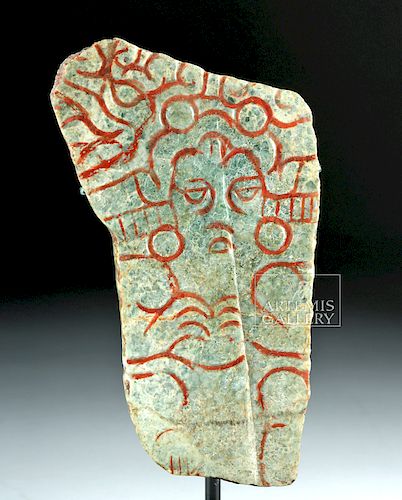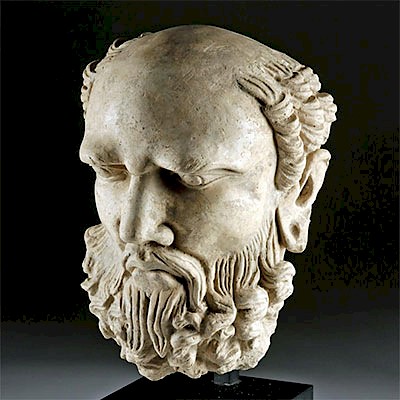Maya Jade Oblong Pectoral w/ God & Quetzalcoatl
Lot 219
About Seller
Artemis Fine Arts
686 S Taylor Ave, Ste 106
Louisville, CO 80027
United States
Selling antiquities, ancient and ethnographic art online since 1993, Artemis Gallery specializes in Classical Antiquities (Egyptian, Greek, Roman, Near Eastern), Asian, Pre-Columbian, African / Tribal / Oceanographic art. Our extensive inventory includes pottery, stone, metal, wood, glass and textil...Read more
Estimate:
$8,500 - $12,750
Absentee vs Live bid
Two ways to bid:
- Leave a max absentee bid and the platform will bid on your behalf up to your maximum bid during the live auction.
- Bid live during the auction and your bids will be submitted real-time to the auctioneer.
Bid Increments
| Price | Bid Increment |
|---|---|
| $0 | $25 |
| $300 | $50 |
| $1,000 | $100 |
| $2,000 | $250 |
| $5,000 | $500 |
| $10,000 | $1,000 |
| $20,000 | $2,500 |
| $50,000 | $5,000 |
| $100,000 | $10,000 |
| $200,000 | $20,000 |
About Auction
By Artemis Fine Arts
Jan 16, 2020
Set Reminder
2020-01-16 10:00:00
2020-01-16 10:00:00
America/New_York
Bidsquare
Bidsquare : Ancient | Asian | Ethnographic
https://www.bidsquare.com/auctions/artemis-gallery/ancient-asian-ethnographic-4799
Featuring classical antiquities, ancient and ethnographic art from cultures encompassing the globe. Artemis Fine Arts info@artemisfinearts.com
Featuring classical antiquities, ancient and ethnographic art from cultures encompassing the globe. Artemis Fine Arts info@artemisfinearts.com
- Lot Description
Pre-Columbian, Southern Mexico to Guatemala, Mayan Territories, Maya, Late Classic period, ca. 550 to 900 CE. A stunning pectoral of an oblong rectangular form, hand-carved from a gorgeous slice of mottled green jade with pale yellow and orange inclusions. Carved atop the obverse face is a depiction of a seated deity with bent legs and finger tips touching in front of a wide chest. The god wears large circular earspools beneath a grand headdress with a wavy frontal band and curving terminals from which hang a pair of segmented fringe panels. The left corner displays a wondrous portrayal of Quetzalcoatl/Kukulkan, the primordial feathered serpent god associated with intelligence and the creation of the world. A central vertical ridge along the middle of the ornament displays the area where another large slice of jade was carved off. The intricate carvings of this piece have been vigorously rubbed with bright red cinnabar, imbuing a regal bichrome appearance to this excellent example of Mayan ornamentation! Custom museum-quality display stand included. Size: 3.1" W x 5" H (7.9 cm x 12.7 cm); 6" H (15.2 cm) on included custom stand.
To the indigenous of the ancient Americas, jade was a stone that carried powerful symbolism. Jade ornaments were used in ceremonial rituals and as adornments for the elite. Jade was revered by the Maya not only for its beauty, but also because it had spiritual power - it was believed to be the embodiment of the wind and the "breath" that formed the Maya soul. In addition, scholars argue that its color was associated with water and vegetation. While the Maya used jade beads to create impressive jewelry, we also know that they placed jade beads in the mouths of the dead, perhaps as a means of extending the circle of life. Furthermore, many scholars have argued that the demand for jade contributed to the rise of long distance trading networks as well as the rise of urban centers in ancient Mesoamerica.
Quetzalcoatl (or Kukulkan) was a powerful god among the indigenous of the Americas. Kukulkan's meaning to the Maya world is not fully understood, but we know that for the Aztecs, the same figure is associated with the wind, the creation of arts and crafts, and knowledge. In addition, a serpent is sometimes used in Mayan iconography as the embodiment of the sky itself. According to the pioneering Mexican artist/anthropologist Miguel Covarrubias, whose classic tomes and illustrations continue to contribute to scholarly studies today, "Quetzalcoatl stood for all that was good in this world: peace, art, wisdom, and prosperity. Disguised as an ant, he discovered maize, the staple food of the Indians, hidden under the mountain of Substance, Tonacatepetl; he also invented the arts, the sciences, and the calendar. In fact, everything connected with wisdom and culture was attributed to Quetzalcoatl." (Covarrubias, Miguel. Mexico South: The Isthmus of Tehuantepec. Alfred A. Knopf, New York, 1946, p. 130)
Provenance: ex-private Santa Fe, New Mexico, USA collection, acquired from Ron Messick Gallery, Santa Fe, New Mexico, USA before 2004
All items legal to buy/sell under U.S. Statute covering cultural patrimony Code 2600, CHAPTER 14, and are guaranteed to be as described or your money back.
A Certificate of Authenticity will accompany all winning bids.
We ship worldwide and handle all shipping in-house for your convenience.
#138081Surface wear and abrasions commensurate with age and use, some fading to carved details and cinnabar additions, small nicks around peripheries, and some minor chips to drilled suspension holes. Light earthen deposits throughout. Five small drilled suspension holes on lateral sides.Condition
- Shipping Info
-
All shipping is handled in-house for your convenience. Your invoice from Artemis Gallery will include shipping calculation instructions. If in doubt, please inquire BEFORE bidding for estimated shipping costs for individual items.
-
- Buyer's Premium



 EUR
EUR CAD
CAD AUD
AUD GBP
GBP MXN
MXN HKD
HKD CNY
CNY MYR
MYR SEK
SEK SGD
SGD CHF
CHF THB
THB














